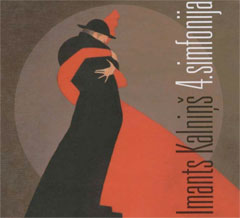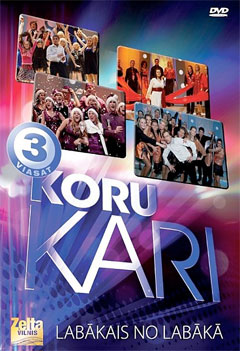
One of the most intriguing recent collaborations in Latvian music is that of composer Valts Pūce and the Georgian ensemble The Shin. Joining together on the recording entitled Es arī, their talents have produced a unique album, combining elements of Latvian and Georgian folk songs, as well as jazz and other world music elements.
Some readers might know Pūce from his music for the Latvian musical “Šveiks” (based on the satirical novel The Good Soldier Švejk by Czech author Jaroslav Hašek), particular the enduringly popular song “Ardievu, meitenes!” performed by Latvian pop group Prāta vētra.
Others may be aware of Pūce’s earlier world music work with Owl’s Ethnographic Orchestra (Pūces Etnogrāfiskais orķestris, pūce literally translating to “owl” in English) and the album Šaizemē / Taizemē. Pūce has dabbled in many types of composition, and those who had the opportunity to attend the 2008 Latvian Song Festival in Rīga would have heard two of his choral works at the closing concert, “Gaismeņa ausa, sauleite lēce” and “Ik rudeni valodiņa.”
Continuing his exploration of world music, Pūce and members of Owl’s Ethnographic Orchestra last year joined with The Shin (Zaza Miminoshvili, Zurab Gagnidze and Mamuka Gaganidze) to record an album inspired by Latvian and Georgian folk music. Also heard on Es arī are the well-known and respected folk singers Zane Šmite (who has performed with Iļģi and Lidojošais paklājs) and Kristīne Kārkle (who has performed with Laimas Muzykanti and Ceiruleits).
Though it is inspired by folk music, I would hesitate to call this a folk music album. It is certainly more “world music,” as there many other elements at work here, including jazz and perhaps even bits of new age. The music is difficult to characterize, as the style tends to change, frequently in mid-song. Vocals are in both Latvian and Georgian, and songs feature traditional instruments of both cultures. The album also features an eclectic mix of guest performers, such as Valdis Muktupāvels on kokles, Normunds Šnē on oboe and Raimonds Ozols on violin, among many others.
Someone once remarked to me that any Latvian folk music album is incomplete unless it has a song with “līgo” (referring to the Latvian midsummer celebration), “kaladū” (a frequently used refrain in folk songs that relate to winter), and references to “kumeliņš” (a young horse, an animal that frequently appears in Latvian folk songs). Es arī gets all three, with songs entitled “Līgo” and “Kaladoo,” plus references to “divi dzelteni kumeliņi” in the song “Es arī.”
“Līgo” begins sounding like a traditional midsummer song, with accordion, but swiftly moves into a mix of modern and traditional elements. Then, mid-song, it switches to Georgian elements. Though the switches in this and other songs is rather dramatic, they are never jarring and more often than not seem to be natural progressions to and from different folk elements.
Šmite has one of the most distinct voices in Latvian music—a rich alto that is unique and immediately recognizable to listeners. For example, in “Līgo” Šmite’s resonant voice adds a particularly robust feel to the song. And, in a song that could almost qualify as pop music, “E-O” (which features the vowels “E” and “O”) Šmite and Kārkle balance each other artfully to make the song one of the catchiest on the album.
My favorite song is the title track, “Es arī,” which begins with an almost Middle Eastern melody, transforms into melodic Georgian chanting, and then slowly and gradually builds up to a dramatic climax of Latvian melodies featuring Kārkle’s expressive and striking singing, and ends with a very ethereal Georgian a capella vocal.
Though the lyrics aren’t included in the packaging, the liner notes have a brief explanation of each song in English and in Latvian, as well as some quotes from Pūce and The Shin, plus pictures of the creation process.
Listeners who enjoy Kārkle’s and Šmite’s singing may also want to check out this year’s Latviešu tautasdziesmas by Trio Šmite Kārkle Cinkuss, which features them performing together with choir director Ivars Cinkuss.
Es arī is certainly one of my favorite compact discs of 2009. Unique, eclectic, original and memorable, the collaboration captivatingly balances the ancient and the modern, the Latvian and the Georgian, to make an album that can be enjoyed by a broad spectrum of listeners. Pūce and The Shin have made a truly remarkable and memorable record.
Details
Es arī
Valts Pūce and The Shin
Pasaules mūzika, 2009
Track listing:
Nākotnes meža dziesma
Vectēvs
Burdu Lūris
KGB dziesmiņa
Ceļš uz kāpnēm
Kā sviežas, čangal
Līgo
Madara
Kaladoo
E-O
Dzeguze
Es arī
Titri





